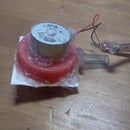Introduction: Emergency USB Charger
You may be camping in the woods, experiencing a natural disaster, or in a place where electricity is unavailable. You may want to charge your phone to keep updated on news or stay connected with friends or family. This device works with apple, android, and many other phones/ MP3 players
Step 1: Drill and Cut
Now you take your encasement and you mark out where each of your plugs go. You can decide yourself or model it off of what I did. When all are cut/drilled, glue all securely in place.
Step 2: Soldering
Solder on the wires to the correct plugs. I suggest color coding. NOTE: only solder wires onto the USB an banana plugs. Now, the two middle prongs are for data. In order to charge a apple device, you must add on two 150k OHM resistors to the circuit. Follow the diagram I created below for hook up details. Also keep in mind that this comes AFTER the regulator is hooked up so only solder the two resistors onto the data prongs for now.
Step 3: Regulator and Plug Placement
Glue the floppy disk plug to the encasement and let dry. Use 3 of the wires (yellow+two blacks) for the regulator and push the red out of the way. The picture below gives the pinout of the regulator. So basically input is the battery or solar panel, ground is negative, and output is 5v for the USB. NOTE: do not attach any other wires yet.
Step 4: Connecting the Wires
Follow the diagram to hook up the wires. In case you don't understand it, here is instructions on how to do it. take the positive in and connect it to the the yellow wire on the floppy disk plug. Then, connect both negative wires from the USB and banana jacks by twisting them together. Then connect them to the first black wire on the floppy disk plug. Then connect the positive USB wire to the second black wire.
Step 5: Insulating and Finishing
Once all the wires are connected properly, wrap electrical tape around all of the exposed wires that we twisted together. Then put a heat sink on the back of the regulator. Next bend all three pins at a 90 degree angle so that the pins are in front of the writing. then insert into the plug. make sure that they are in the yellow and the 2 black slots. no pins should be in the red slot.
Step 6: Tips and Pointers
You can use a whole range of power sources to use this. So far, i have used solar panels and a 9v battery. If you use a 9v battery, it continuously charges until its voltage drops below a certain level. With solar panels, It charges for as long a you have enough light. One problem is that you have to come up with at least 10v to charge one device. I have not tried charging two devices yet but it is possible. If you have any questions, please ask me and I will get back to you as soon as possible.
Project_Builder













